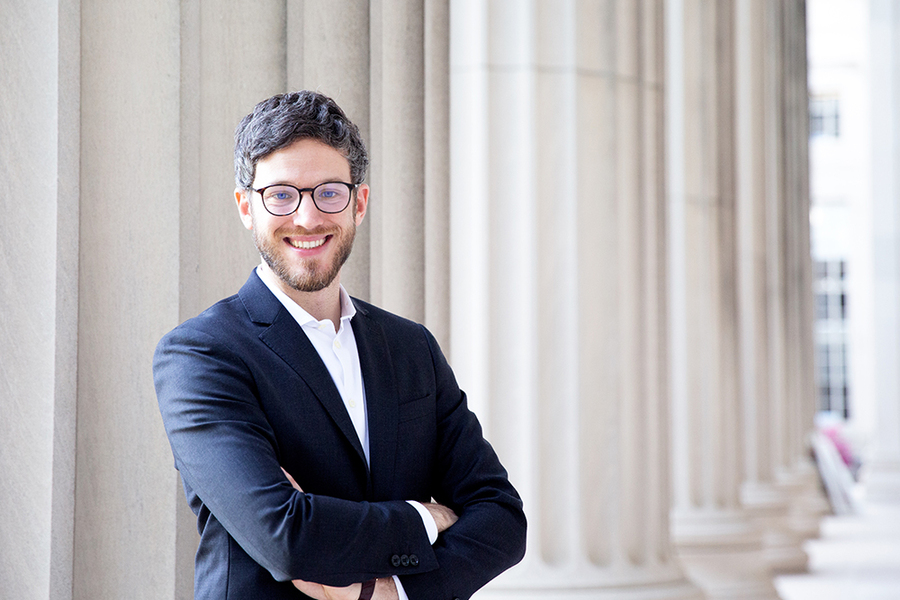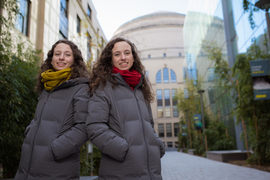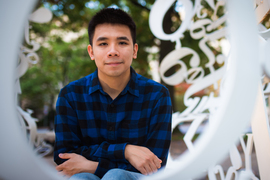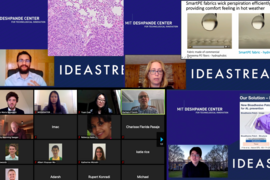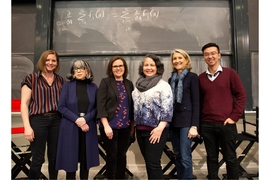MIT postdoc Francesco Benedetti admits he wasn’t always a star student. But the people he met along his educational journey inspired him to strive, which led him to conduct research at MIT, launch a startup, and even lead the team that won the 2021 MIT $100K Entrepreneurship Competition. Now he is determined to make sure his company, Osmoses, succeeds in boosting the energy efficiency of traditional and renewable natural gas processing, hydrogen production, and carbon capture — thus helping to address climate change.
“I can’t be grateful enough to MIT for bringing together a community of people who want to change the world,” Benedetti says. “Now we have a technology that can solve one of the big problems of our society.”
Benedetti and his team have developed an innovative way to separate molecules using a membrane fine enough to extract impurities such as carbon dioxide or hydrogen sulfide from raw natural gas to obtain higher-quality fuel, fulfilling a crucial need in the energy industry. “Natural gas now provides about 40 percent of the energy used to power homes and industry in the United States,” Benedetti says. Using his team’s technology to upgrade natural gas more efficiently could reduce emissions of greenhouse gases while saving enough energy to power the equivalent of 7 million additional U.S. homes for a year, he adds.
The MIT community
Benedetti first came to MIT in 2017 as a visiting student from the University of Bologna in Italy, where he was working on membranes for gas separation for his PhD in chemical engineering. Having completed a master’s thesis on water desalination at the University of Texas (UT) at Austin, he connected with UT alumnus Zachary P. Smith, the Robert N. Noyce Career Development Professor of Chemical Engineering at MIT, and the two discovered they shared a vision. “We found ourselves very much aligned on the need for new technology in industry to lower the energy consumption of separating components,” Benedetti says.
Although Benedetti had always been interested in making a positive impact on the world, particularly the environment, he says it was his university studies that first sparked his interest in more efficient separation technologies. “When you study chemical engineering, you understand hundreds of ways the field can have a positive impact in the world. But we learn very early that 15 percent of the world’s energy is wasted because of inefficient chemical separation — because we still rely on centuries-old technology,” he says. Most separation processes still use heat or toxic solvents to separate components, he explains.
Still, Benedetti says, his main drive comes from the joy of working with terrific mentors and colleagues. “It’s the people I’ve met that really inspired me to tackle the biggest challenges and find that intrinsic motivation,” he says.
To help build his community at MIT and provide support for international students, Benedetti co-founded the MIT Visiting Student Association (VISTA) in September 2017. By February 2018, the organization had hundreds of members and official Institute recognition. In May 2018, the group won two Institute awards, including the Golden Beaver Award for enhancing the campus environment. “VISTA gave me a sense of belonging; I loved it,” Benedetti says.
Membrane technology
Benedetti also published two papers on membrane research during his stint as a visiting student at MIT, so he was delighted to return in 2019 for postdoctoral work through the MIT Energy Initiative, where he was a 2019-20 ExxonMobil-MIT Energy Fellow. “I came back because the research was extremely exciting, but also because I got extremely passionate about the energy I found on campus and with the people,” he says.
Returning to MIT enabled Benedetti to continue his work with Smith and Holden Lai, both of whom helped co-found Osmoses. Lai, a recent Stanford PhD in chemistry who was also a visiting student at MIT in 2018, is now the chief technology officer at Osmoses. Co-founder Katherine Mizrahi Rodriguez ’17, an MIT PhD candidate, joined the team more recently.
Together, the Osmoses team has developed polymer membranes with microporosities capable of filtering gases by separating out molecules that differ by as little as a fraction of an angstrom — a unit of length equal to one hundred-millionth of a centimeter. “We can get up to five times higher selectivity than commercially available technology for methane upgrading, and this has been observed operating the membranes in industrially relevant environments,” Benedetti says.
Today, methane upgrading — removing carbon dioxide (CO2) from raw natural gas to obtain a higher-grade fuel — is often accomplished using amine absorption, a process that uses toxic solvents to capture CO2 and burns methane to fuel the regeneration of those solvents for reuse. Using Osmoses’ filters would eliminate the need for such solvents while reducing CO2 emissions by up to 16 million metric tons per year in the United States alone, Benedetti says.
The technology has a wide range of applications — in oxygen and nitrogen generation, hydrogen purification, and carbon capture, for example — but Osmoses plans to start with the $5 billion market for natural gas upgrading because the need to bring innovation and sustainability to that space is urgent, says Benedetti, who received guidance in bringing technology to market from MIT’s Deshpande Center for Technological Innovation. The Osmoses team has also received support from the MIT Sandbox Innovation Fund Program.
The next step for the startup is to build an industrial-scale prototype, and Benedetti says the company got a huge boost toward that goal in May when it won the MIT $100K Entrepreneurship Competition, a student-run contest that has launched more than 160 companies since it began in 1990. Ninety teams began the competition by pitching their startup ideas; 20 received mentorship and development funding; then eight finalists presented business plans to compete for the $100,000 prize. “Because of this, we’re getting a lot of interest from venture capital firms, investors, companies, corporate funds, et cetera, that want to partner with us or to use our product,” he says. In June, the Osmoses team received a two-year Activate Fellowship, which will support moving its research to market; in October, it won the Northeast Regional and Carbon Sequestration Prizes at the Cleantech Open Accelerator; and in November, the team closed a $3 million pre-seed round of financing.
FAIL!
Naturally, Benedetti hopes Osmoses is on the path to success, but he wants everyone to know that there is no shame in failures that come from best efforts. He admits it took him three years longer than usual to finish his undergraduate and master’s degrees, and he says, “I have experienced the pressure you feel when society judges you like a book by its cover and how much a lack of inspired leaders and a supportive environment can kill creativity and the will to try.”
That’s why in 2018 he, along with other MIT students and VISTA members, started FAIL!–Inspiring Resilience, an organization that provides a platform for sharing unfiltered stories and the lessons leaders have gleaned from failure. “We wanted to help de-stigmatize failure, appreciate vulnerabilities, and inspire humble leadership, eventually creating better communities,” Benedetti says. “If we can make failures, big and small, less intimidating and all-consuming, individuals with great potential will be more willing to take risks, think outside the box, and try things that may push new boundaries. In this way, more breakthrough discoveries are likely to follow, without compromising anyone’s mental health.”
Benedetti says he will strive to create a supportive culture at Osmoses, because people are central to success. “What drives me every day is the people. I would have no story without the people around me,” he says. “The moment you lose touch with people, you lose the opportunity to create something special.”
This article appears in the Autumn 2021 issue of Energy Futures, the magazine of the MIT Energy Initiative.
